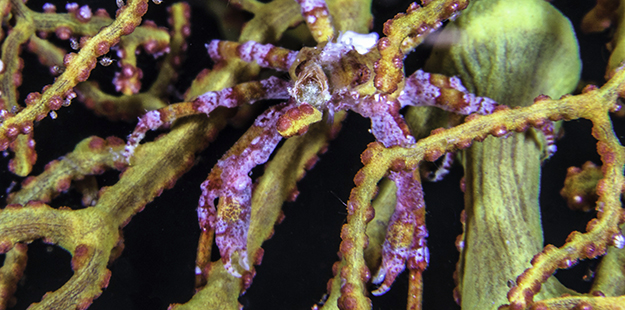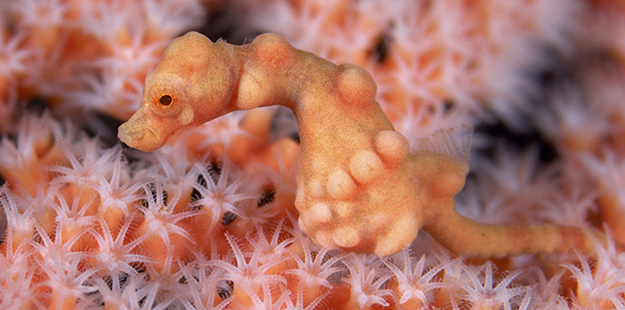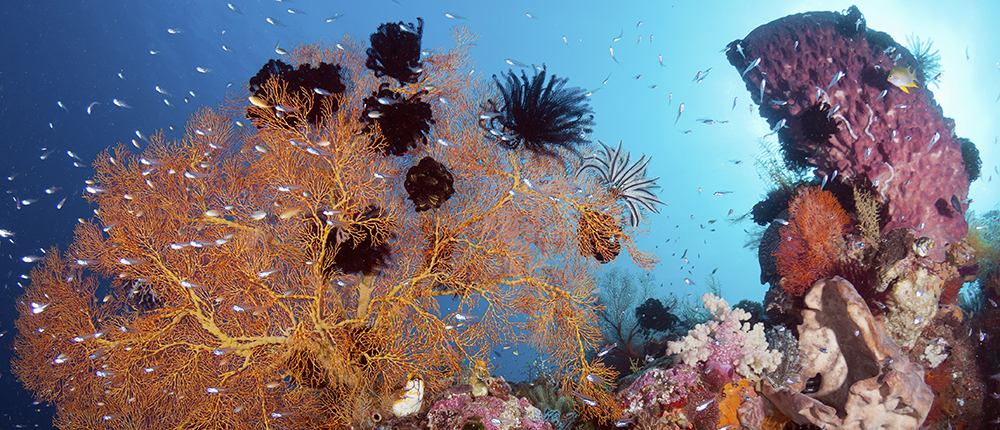Fan Favorites

Almost every sea fan plays home to a resident population of spider crabs. Look closely as this crab’s carapace is typically shaped and colored to match it’s host. Photo by Wayne MacWiliams
Look closer till and you will likely find the smaller branches crawling with gorgonian spider crabs. At first, you may mistake this crab for one of the sea fan’s own polyps, as this crab’s carapaces is shaped and colored to match it’s host. In addition, these wily scavengers will sometimes nip off a bit of the fan and attach it to themselves as camouflage. If you don’t find spider crabs. look closer, because most every sea fan plays home to a resident population.

Pygmy seahorses are completely dependent on gorgonians, living their entire adult lives on a single sea fan. Four of the seven species of pygmy seahorse are found on Wakatobi’s reefs. Photo by Richard Smith
Another diminutive and elusive group of animals that don’t provide a guaranteed sighting are the members of the Syngnathidae family—the pygmy seahorses. Four of the seven known species of pygmy seahorse are found at Wakatobi, and two of these, the Bargibant’s and the Denise’s, are completely dependent on gorgonians, living their entire adult lives on a single sea fan. With most pygmies reaching less than 1cm from head to toe, a sharp eye is required to witness this amazing spectacle. That’s when the assistance of Wakatobi’s dive guides really pays off. Finding these little darlings of the sea fan can present a challenge. They are marvelously camouflaged – often having the same color and texture as the branches of their home. If pygmies feel threatened they are known to turn their backs to anything that approaches, making them even harder to distinguish from the fan’s tiny polyps. Patience and making slow and deliberate movements are always recommended for a positive view of this little celebrity.

Want to discover something new on the reef? Find a sea fan and look closely, branch by branch. Photo by Walt Stearns
While looking for pygmy seahorses, you just might encounter a close relative, the ornate ghost pipefish. Also small and highly colorful, the ornate, aka harlequin ghost pipefish, are regular sea fan dwellers and rank among the most exotic creatures in the Indo-Pacific. Their spike-shaped fin rays give them a jagged appearance like the arms of a crinoid. In addition to finding them hovering close to the crinoid’s arms, they will also make themselves indistinctive by drafting off the waving motion of a sea fan as it sways in the current. The sea fan’s billowy branches also serve as effective sanctuaries for hosts of other sea creatures during their juvenile development. Some of the most tantalizing finds for those with a keen eye are baby cuttlefish and squid which are no bigger than a grain of rice. Without using the sea fan’s protective forest of branches this little guy would more easily become somebody’s fast food lunch.
So the next time you are on the reef and want to discover something new, find a sea fan and look closely, branch by branch. Who knows what wonders it may be harboring. Of course, there’s no better place on the planet to explore sea fans than at Wakatobi Resort. Contact us at office@wakatobi.com or complete a quick trip inquiry today!


